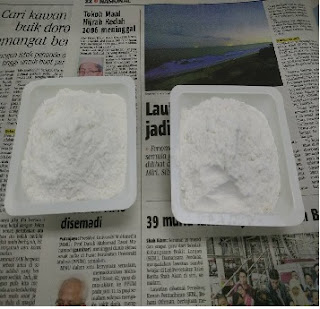Title
: Particle size and shape analysis using microscope
Objective : To determine the particle size and shape analysis on different types of sands
and powder such as MMC and lactose
Apparatus
: microscope, slide, cover slip, spatula
Chemicals
: sands (150µ, 355µ, 500µ, 850µ, mixed), MMC, lactose
Introduction
:
Microscopy
is a method that allows the individual particles to be observed and measured. A
digital camera with a fixed magnification lens is used to take a picture of a
sparse layer of representative particles distributed on the microscope slide.
An image analysis program is used to obtain measurements by analysing the
number and shade of individual pixels. Only a small quantities of
representative particles are needed in the analysis. For this experiment, we
will be using a microscope to analyse 5 different types of sands (150µ, 355µ,
500µ, 850µ and mixed) and powders (MMC
and lactose) with particular emphasize on the size and shape of the particles.
The particles observed microscopically are being sketch and the general shape
for the particular material are being determined. Magnification used should be
the same for sketching the particles.
Experimental procedure
:
1.
A microscope was used to analyse 5 different types of sands which are 850mic,
500mic, 355mic, 150mic, various sizes, and powders (MCC and lactose).
2.
The particles observed microscopically were then sketched and the general
shapes for that particular material were determined.
3.
The magnification used in sketching the materials was fixed.
Result
:
Discussion
:
In pharmaceuticals, particle size
analysis is important to ensure the efficacy of drugs in the body. Particle
size influences the rate of dissolution of drug in which, smaller particle
has a larger surface area that dissolves rapidly than the larger one.
Other than that, particle size and shape affects the flow properties of powders.
Basically, coarse, roughly spherical particles flow easier than
elongated particles. Particle size also affects the stability of dispersion such
as suspension and emulsions.
There are many ways to determine the
size and shape of particle and one of the ways is by using microscope. In this
experiment, light microscope is used to analyse the size and shape of sands.
The sands observed include 850µ, 500µ, 355µ, 150µ and various size. Other than
sand, two powders was also being analysed and they are lactose and
microcrystalline cellulose (MCC).
Based on the result obtained from
the experiment, we observed that the sands have different sizes and irregular
shape between each other. If compared to the powders, powders are smaller in
size but their shapes are also irregular. Sand 150 mic is has the smallest size
among all sands while between both powders, MCC is smaller than lactose.
Precaution steps must be taken while
conducting the experiment such as wearing goggles to avoid any small particles from the experiment from entering the eye and wearing gloves to prevent any particles from having direct contact with the skin. Besides, the sands
and powders must be placed on the slide as a thin one layer so that it will be easier to be observed under the microscope. The experiment should be conducted carefully to prevent the materials from spilling out anywhere and being wasted.
Questions :
1. Explain in brief the various statistical methods that you can use to measure the diameter of a particle.
There
are two types of statistical methods that can be used to measure the diameter
of a particle such as the Martin’s and Feret’s diameter and the histogram.
Martin’s diameter is defined as the averaged cord length of a particle which
equally divides the projected area. Feret’s diameter is averaged distance
between pairs of parallel tangents to the projected outline of the particle.
The projected area diameter is the diameter of a sphere having the same
projected area as the particle. The histogram shows the distribution of sizes
of the particle in different size range.
Martin’s
and Feret’s diameter of a particle depend on the orientation of particle which
is made by the measurement. A large number of randomly sampled particles is needed to obtain a significant measurement at a fixed orientation. Usually Martin's and Feret's diameter method is used in optical and electron microscope. The histogram method
will be used when most powders contain particle of different diameters. The histogram method is being used as it show the distribution of size particles in three
types such as normal distribution, positive skewed distribution and bimodal
distribution.
2. State the best statistical method for each of the samples that you have analysed.
2. State the best statistical method for each of the samples that you have analysed.
The
most suitable statistical method for the samples that we had analysed is
Martin’s and Feret’s diameter. This is because we are observing the particle
under a microscope during the experiment. Thus, this is the most suitable
method to measure the diameter of the particle.
Conclusion
:
Different
types of sands and powders can be analysed through a light microscope. Each of
the particles is different in shape and size. Overall we are able to determine
the shape of the particles and we can conclude that they are asymmetrical and
irregular. This shows that the granulation is important to ensure that the flow
ability of drug can be achieved.
References :
1. Keping,
Sun. Recent Developments in Applied Electrostatics Proceedings of the Fifth
International Conference on Applied Electrostatics, November 2-5, 2004,
Shanghai, China. S.l.: Elsevier Science, 2005. Print.
2. Reider,
Ralf, and I-Wei Chen. Ceramics Science and Technology: Vol. 3. Weinheim:
Wiley-VCH Verlag GmbH, 2011. Print.
3. Augsburger,
Larry L. Pharmaceutical Dosage Forms Tablets. 3.rd ed. New York: Informa
Healthcare, 2008. Print.
4. Michael
E. Aulton, Aulton’s Pharmaceutics The Design And Manufacture of Medicine, 3rd
Edition (2007), Churchill Livingstone Elsevier (page 122-134)
5. A. T. Florence and D. Attwood, Physicochemical
Principals of Pharmacy, 2nd Edition, The Macmillan Press Ltd.










